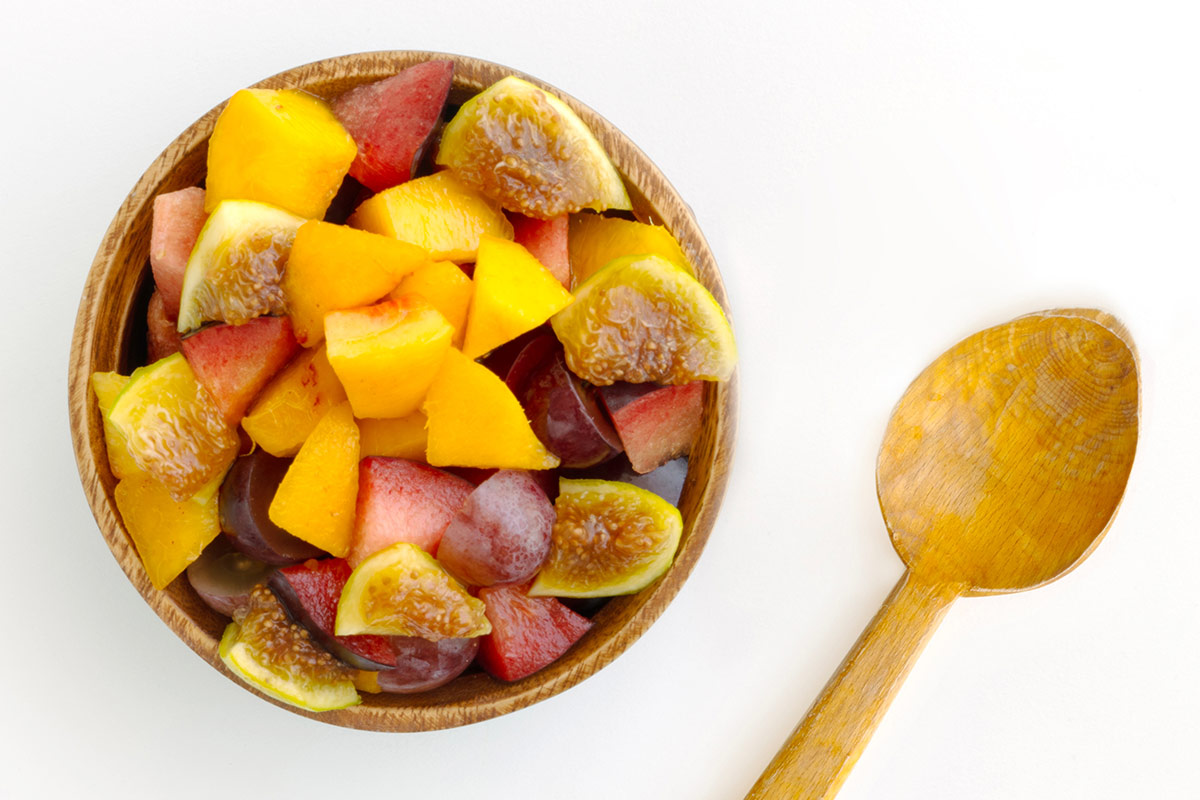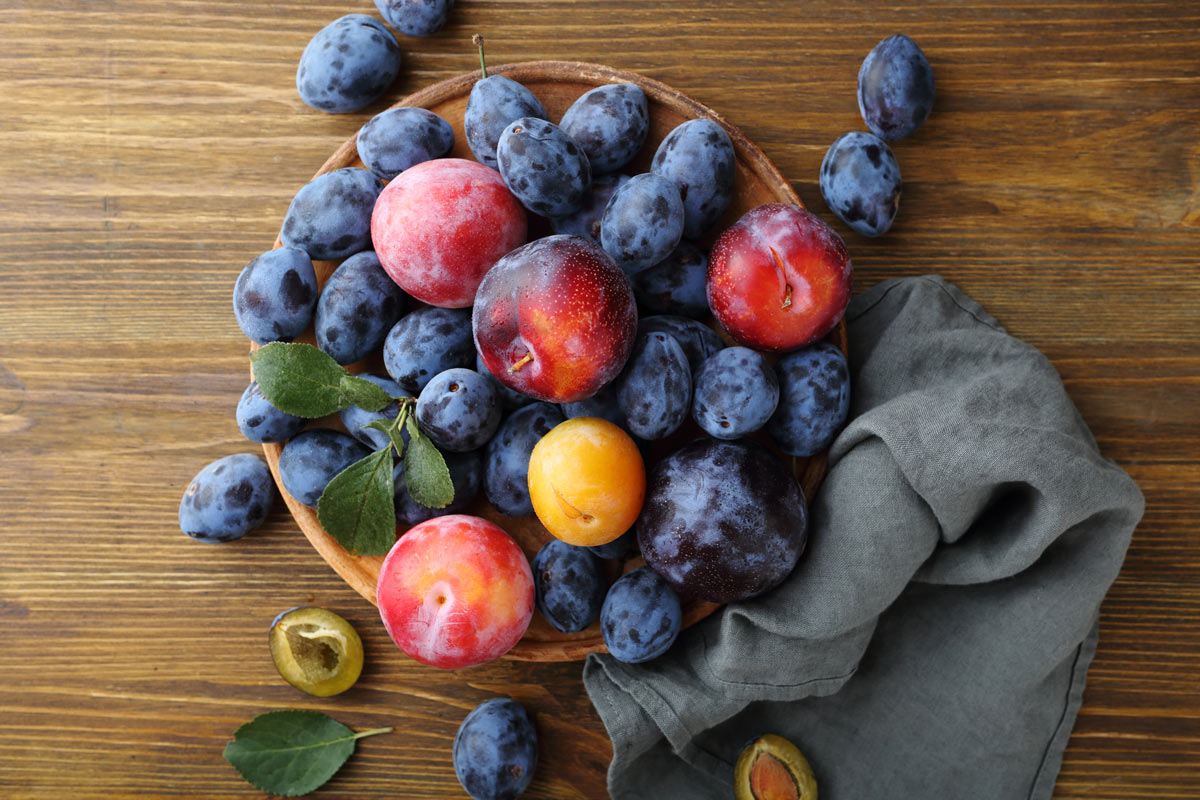Late Summer Fruit Salad Recipe, Spotlight on Nectarines, Zesting-then Squeezing, Ultra-Processed Foods (UPFs) and Your Sleep, Preventing Falls
It’s still stone fruit season—the perfect excuse for a luscious fruit salad with a zesty dressing. My recipe is a great example of healthy eating that still tastes indulgent. Enjoying “whole” foods, meaning foods in their most natural state, is the antidote to the dangers of ultra-processed foods, which now include insomnia. Read more on this below, along with a new advisory on avoiding falls for people over 65—food for thought for anyone at risk for falling, regardless of age.
Late Summer Fruit Salad
 Late Summer Fruit Salad
Late Summer Fruit SaladStone fruit—nectarines, peaches, and plums—are the stars of this juicy dessert, with figs, berries, and a sweet and citrusy dressing in supporting roles. This salad, high in antioxidants, also makes a delicious breakfast
Ingredients
- 2 nectarines
- 2 plums
- 2 peaches
- 1/4 cup extra virgin olive oil
- 2 tablespoons apple balsamic vinegar
- 1 tablespoon local honey
- Zest and juice of 1 lime (see “Quick Kitchen Nugget” in newsletter)
- 1 tablespoon chopped spearmint leaves
- 2 fresh figs, quartered
- 1 cup whole blackberries, rinsed and patted dry
Directions
Pit and section the stone fruit, then place in a large serving bowl. In a small bowl, whisk together the olive oil, vinegar, and honey. Whisk in the lime juice, zest, and mint. Pour the dressing over the fruit in the bowl and toss gently. Allow the juices and the dressing to meld for 30 minutes. Just before serving, arrange the figs and blackberries on top of the stone fruit.
Yields 4 servings

Healthy Ingredient Spotlight
Nectarines

Think of nectarines as peaches’ little siblings. The main difference between the two popular fruits is simply genetic—nectarines lack the fuzz gene that peaches have. Also, nectarines tend to be smaller and firmer yet sweeter and more intensely flavored and scented than peaches…a strong aroma is a key sign of ripeness.
As with peaches, there are dozens of varieties to choose from, though they fall into the same main categories: freestone and cling free (cling-free varieties making slicing much easier) as well as white and yellow flesh. Nectarines are antioxidant rich and have twice the amount of vitamin A and slightly more vitamin C and potassium than peaches, along with vitamin E, B vitamins, calcium, fiber, and some iron.
To ripen nectarines, store them at room temperature until they’re no longer firm. If you can’t eat them right away, you can refrigerate them, but for no more than three to five days.

Quick Kitchen Nugget
Zest, then Squeeze
Whenever a recipe calls for zest and juice from a piece of citrus, always zest first, optimally with a handheld Microplane grater. It’s not only easier than trying to zest halves, but you’ll also get the most zest. When juiving, if you’re using a handheld press, always position the fruit cut-side down into the empty cup to extract the most juice.

For Your Best Health
Why Those Chips Are Wrecking Your Sleep
We know that ultra-processed foods (UPFs) are the unhealthiest food choices because they have the highest levels of saturated fats, starches, and added sugars plus all sorts of additives like artificial colors and flavors; are devoid of nutrients; and have virtually no fiber. Packaged baked goods and snacks, frozen foods, and processed meats are typically considered ultra-processed. Much of the research on the detriments of UPFs has looked at the links between these foods and health conditions such as diabetes, obesity, and cancer. Now a new study has added sleep problems, including chronic insomnia, to that list. This can have a snowball effect on health because sleep disorders and insomnia have independently been linked with anxiety and depression as well as health conditions like diabetes and heart disease. With sleep health now a wellness goal on its own right, a better diet can be one way to get there.
Lead investigator Marie-Pierre St-Onge, PhD, associate professor of nutritional medicine and director of Columbia University Irving Medical Center of Excellence for Sleep & Circadian Research, said, “At a time when more and more foods are highly processed and sleep disturbances are rampant, it is important to evaluate whether diet could contribute to adverse- or good-quality sleep. Our research team had previously reported associations of healthy dietary patterns, like the Mediterranean diet, with a reduced risk of insomnia and poor sleep quality (both cross-sectionally and longitudinally), and high-carbohydrate diets with an elevated risk of insomnia.”

For this cross-sectional study, Dr. St-Onge and some of her colleagues included 38,570 French participants with a mean age of 50 who completed a sleep questionnaire and at least two 24-hour dietary records. An analysis revealed a statistically significant association between ultra-processed food intake and chronic insomnia, independent of participants’ sociodemographic, lifestyle, diet quality, and mental health status. Overall, the study participants got 16 percent of their daily energy from UPFs. Nearly 20 percent of participants reported symptoms of chronic insomnia, and this group tended to eat more ultra-processed foods.
There are various reasons for the diet-sleep link. First, people who eat more saturated fat, trans fat, sodium, and free or added sugars tend to eat less fruit, vegetables, legumes, and seafood, which are all sources of sleep-promoting compounds, the researchers pointed out. Also, ultra-processed foods are highly inflammatory and can negatively affect the gut microbiome—and the gut microbiome is known to play a role in the quality of your shuteye.

Fitness Flash
Preventing Falls
The US Preventive Services Task Force (USPSTF), a volunteer group of experts in different fields from across the country, recently issued its guidance regarding preventing falls in people over age 65. According to the CDC, over 14 million Americans, or one in four adults ages 65 and older, report falling each year, and for about 37 percent, doing so resulted in an injury that required medical treatment or restricted their activity for at least one day.
After its review of existing research, the USPSTF concluded with moderate certainty that exercise interventions provide a moderate net benefit and that multifactorial interventions, such as three-dimensional exercises (movement through all three spatial planes or dimensions: forward and back, side to side, and up and down), provide a small net benefit in preventing falls and fall-related morbidity in older adults at increased risk for falls. Effective exercise interventions include supervised individual physical therapy and group exercise classes.
While the USPSTF stated that it’s difficult to identify specific components of exercise that are particularly effective, the most commonly studied exercise components were gait, balance, and functional training, followed by strength and resistance training, flexibility, and endurance training. A smaller number of trials included three-dimensional exercise, such as group dance or tai chi classes. The most common frequency and duration for exercise interventions was two to three sessions per week for 12 months, although the duration of the studies ranged from two to 30 months.
The USPSTF also recommended that a program be tailored to each individual based on the findings of a health and risk factor assessment that might include balance, gait, vision, postural blood pressure, medication, environment, cognition, and psychological health. This could be done by your doctor or another expert familiar with your health history so that he or she can factor in any chronic medical conditions, medications taken, and alcohol use as well whether you had a prior fall, all of which could affect your fall risk.
The USPSTF statement included a reminder about the multiple health benefits associated with physical activity that go beyond fall prevention: a lower risk of cardiovascular disease events, cardiovascular disease mortality, and all-cause mortality, as well as lower blood pressure, lower risk of type 2 diabetes, and lower risk of high cholesterol. It added: “The US Department of Health and Human Services recommends that adults do at least 150 to 300 minutes per week of moderate-intensity—or 75 to 150 minutes per week of vigorous-intensity—aerobic physical activity, as well as muscle-strengthening activities of moderate or greater intensity and that involve all major muscle groups, twice a week or more.”
Get More Recipes In Your Inbox!